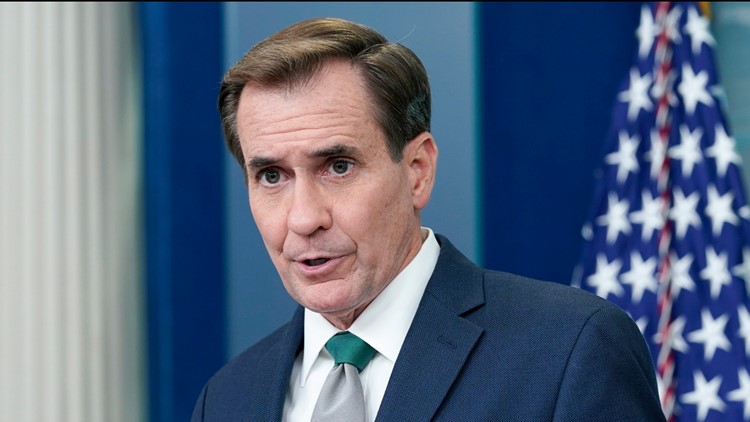WASHINGTON — The White House said Thursday that Iranian troops are “directly engaged on the ground” in Crimea supporting Russian drone attacks on Ukraine's power stations and other key infrastructure, troubling evidence of Tehran's deepening role assisting Russia as it exacts suffering on Ukrainian civilians just as the cold weather sets in.
National Security Council spokesman John Kirby told reporters that Iran has sent a “relatively small number” of personnel to Crimea, a part of Ukraine unilaterally annexed by Russia in contravention of international law in 2014, to assist Russian troops in launching Iranian-made drones against Ukraine. Members of a branch of the Iranian Revolutionary Guard Corps were dispatched to assist Russian forces in using the drones, according to the British government.
The revelation of the U.S. intelligence finding comes as the Biden administration seeks to mount international pressure on Tehran to pull back from helping Russia as it bombards soft Ukrainian civilian targets with the help of Iranian-made drones.
The Russians in recent days have increasingly turned to the Iranian-supplied drones, as well as Kalibr and Iskander cruise missiles, to carry out a barrage of attacks against Ukrainian infrastructure and non-military targets. President Volodymyr Zelenskyy said this week that Russian forces have destroyed 30% of Ukraine’s power stations since Oct. 10.
“The information we have is that the Iranians have put trainers and tech support in Crimea, but it’s the Russians who are doing the piloting," Kirby said.
He added that the Biden administration was looking at imposing new sanctions on Tehran and would look for ways to make it harder for Iran to sell such weapons to Russia.
The U.S. first revealed this summer that Russia was purchasing Iranian unmanned aerial vehicles to launch against Ukraine. Iran has denied selling its munitions to Russia.
White House officials say that international sanctions, including export controls, have left the Russians in a bind as they try to restock ammunition and precision-guided munition stocks that have been depleted during the nearly eight-month-old war. As a result, Russia has been forced to turn to Iran as well as North Korea for weaponry.
Air Force Brig. Gen. Pat Ryder, the Pentagon press secretary, told reporters that military officials “wouldn’t be surprised” if the Russians sought more drones from Iran “given their situation.”
Zelenskyy said last week that Russia had ordered 2,400 from Iran.
U.S. officials believe that Iran may have deployed military personnel to assist the Russians in part because of the Russians' lack of familiarity with the Iranian-made drones. Declassified U.S. intelligence findings showed that Russians faced technical problems with the drones soon after taking delivery of them in August.
“The systems themselves were suffering failures and not performing to the standards that apparently the customers expected,” Kirby said. “So the Iranians decided to move in some trainers and some technical support to help the Russians use them with better lethality.”
The Biden administration released further details about Iran's involvement in assisting Russia's war at a sensitive moment. The administration has levied new sanctions against Iran over the brutal crackdown on antigovernment protests spurred by the death of 22-year-old Mahsa Amini, who died in Iranian security custody.
Morality police had detained Amini last month for not properly covering her hair with the Islamic headscarf, known as the hijab, which is mandatory for Iranian women. Amini collapsed at a police station and died three days later.
Her death and the subsequent unrest have come as the administration tries to bring Iran back into compliance with the nuclear deal that was brokered by the Obama administration and scrapped by the Trump administration.
At the United Nations this week, Ukraine accused Iran of violating a Security Council ban on the transfer of drones capable of flying 300 kilometers (180 miles). Britain, France and the U.S. strongly back Ukraine’s contention that the drones were transferred to Russia and violate a 2015 U.N. Security Council resolution that endorsed the nuclear deal between Iran and six nations — the U.S., Russia, China, Britain, France and Germany — aimed at curbing Tehran’s nuclear activities and preventing the country from developing a nuclear weapon.
Kirby said the administration has little hope for reviving the Iran nuclear deal soon.
“We’re not focused on the on the diplomacy at this point,” Kirby said. “What we are focused on is making sure that we’re holding the regime accountable for the way they’re treating peaceful protesters in their country and supporting those protesters.”
The White House spoke out about Iranian assistance to Russia as Britain on Thursday announced new sanctions on Iranian officials and businesses accused of supplying the drones.
“These cowardly drone strikes are an act of desperation,” British Foreign Secretary James Cleverly said in a statement. “By enabling these strikes, these individuals and a manufacturer have caused the people of Ukraine untold suffering. We will ensure that they are held to account for their actions.”
Among the individuals hit with asset freezes and travel bans by the British were Maj. Gen. Mohammad Hossein Bagheri, chairman of the armed forces general staff overseeing the army branches supplying Russia with drones; Brig. Gen. Seyed Hojjatollah Qureishi, a key Iranian negotiator in the deal; and Brig. Gen. Saeed Aghajani, the head the Iranian Revolutionary Guard Aerospace Force UAV Command.
Shahed Aviation Industries, the Iranian manufacturer of the drones being used by Russia, was also hit by an asset freeze.



